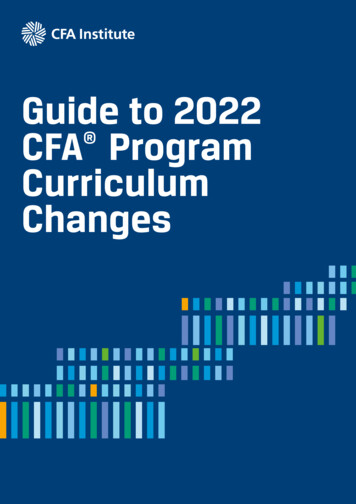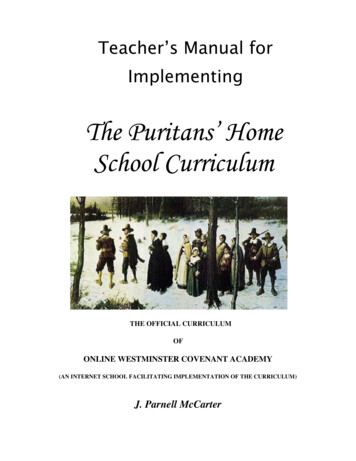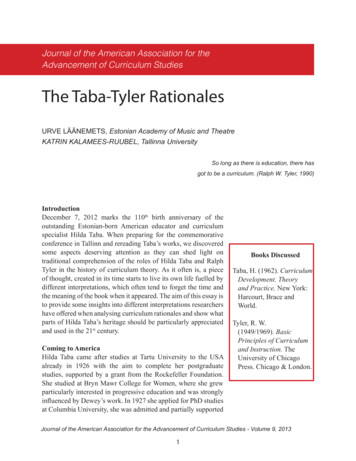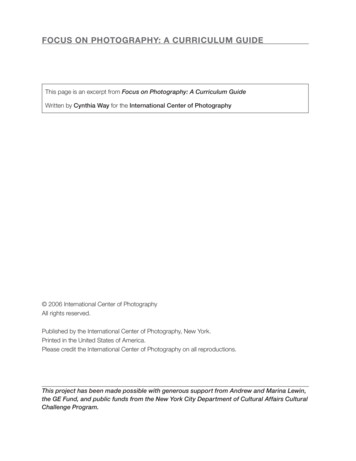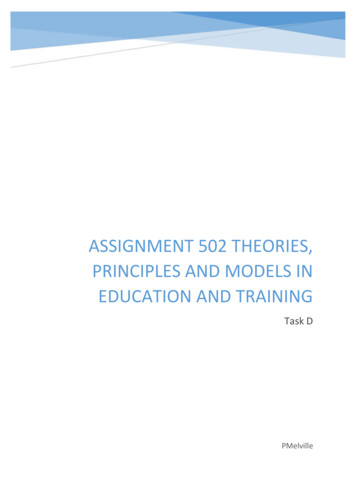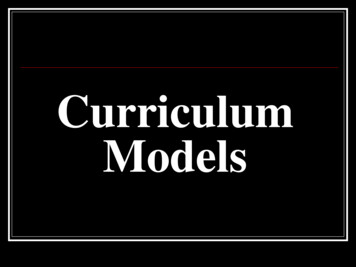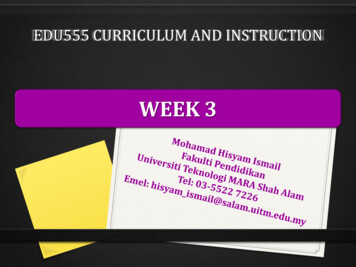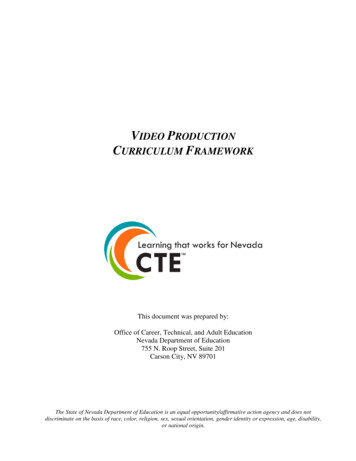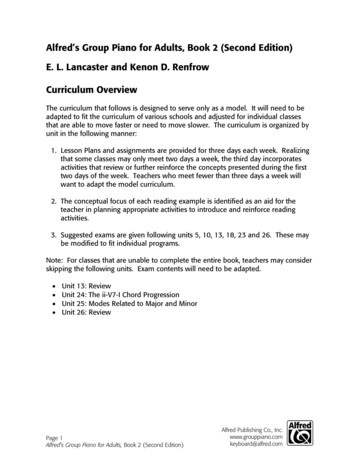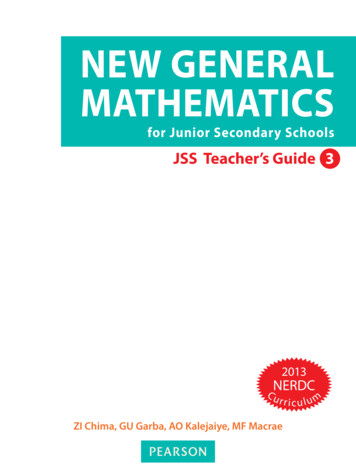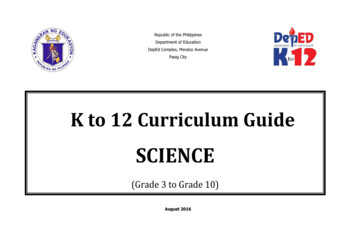
Transcription
Republic of the PhilippinesDepartment of EducationDepEd Complex, Meralco AvenuePasig CityK to 12 Curriculum GuideSCIENCE(Grade 3 to Grade 10)August 2016
K to 12 BASIC EDUCATION CURRICULUMCONCEPTUAL FRAMEWORKScience education aims to develop scientific literacy among learners that will prepare them to be informed and participative citizens who are able to make judgmentsand decisions regarding applications of scientific knowledge that may have social, health, or environmental impacts.The science curriculum recognizes the place of science and technology in everyday human affairs. It integrates science and technology in the social, economic,personal and ethical aspects of life. The science curriculum promotes a strong link between science and technology, including indigenous technology, thus preserving ourcountry’s cultural heritage.The K to 12 science curriculum will provide learners with a repertoire of competencies important in the world of work and in a knowledge-based society. It envisionsthe development of scientifically, technologically, and environmentally literate and productive members of society who are critical problem solvers, responsible stewards ofnature, innovative and creative citizens, informed decision makers, and effective communicators. This curriculum is designed around the three domains of learning science:understanding and applying scientific knowledge in local setting as well as global context whenever possible, performing scientific processes and skills, and developing anddemonstrating scientific attitudes and values. The acquisition of these domains is facilitated using the following approaches: multi/interdisciplinary approach, sciencetechnology-society approach, contextual learning, problem/issue-based learning, and inquiry-based approach. The approaches are based on sound educational pedagogynamely, constructivism, social cognition learning model, learning style theory, and brain-based learning.Science content and science processes are intertwined in the K to 12 Curriculum. Without the content, learners will have difficulty utilizing science process skills sincethese processes are best learned in context. Organizing the curriculum around situations and problems that challenge and arouse learners’ curiosity motivates them to learnand appreciate science as relevant and useful. Rather than relying solely on textbooks, varied hands-on, minds-on, and hearts-on activities will be used to develop learners’interest and let them become active learners.As a whole, the K to 12 science curriculum is learner-centered and inquiry-based, emphasizing the use of evidence in constructing explanations. Concepts and skills inLife Sciences, Physics, Chemistry, and Earth Sciences are presented with increasing levels of complexity from one grade level to another in spiral progression, thus paving theway to a deeper understanding of core concepts. The integration across science topics and other disciplines will lead to a meaningful understanding of concepts and itsapplication to real-life situations.K to 12 Science Curriculum Guide August 2016Learning Materials and equipment technical specifications may be accessed at http://lrmds.deped.gov.ph/.Page 2 of 203*These materials are in textbooks that have been delivered to schools.
K to 12BASIC ronmental LiteracyDeveloping andDemonstrating ScientificAttitudes and ValuesBrain-basedlearningThe Conceptual Framework of Science EducationK to 12 Science Curriculum Guide August 2016Learning Materials and equipment technical specifications may be accessed at http://lrmds.deped.gov.ph/.Page 3 of 203*These materials are in textbooks that have been delivered to schools.
K to 12 BASIC EDUCATION CURRICULUMCORE LEARNING AREA STANDARD: (SCIENCE FOR THE ENTIRE K TO 12)The learners demonstrate understanding of basic science concepts and application of science-inquiry skills. They exhibit scientific attitudes and values to solveproblems critically, innovate beneficial products, protect the environment and conserve resources, enhance the integrity and wellness of people, make informeddecisions, and engage in discussions of relevant issues that involve science, technology, and environment.KEY STAGE STANDARDS: (STANDARDS FOR SCIENCE LEARNING AREAS FOR K-3, 4-6, 7-10 AND 11-2)K–3At the end of Grade 3, thelearners should have acquiredhealthful habits andhavedeveloped curiosity aboutself and their environmentusing basic process skills ofobserving, communicating,comparing, classifying,measuring, inferring andpredicting. This curiosity willhelp learners value science asan important tool in helpingthem continue to explore theirnatural and physicalenvironment. This should alsoinclude developing scientificknowledge or concepts.4–6At the end of Grade 6, the learnersshould have developed the essentialskills of scientific inquiry – designingsimple investigations, using appropriateprocedure, materials and tools to gatherevidence, observing patterns,determining relationships,drawingconclusions based on evidence, andcommunicating ideas in varied ways tomake meaning of the observationsand/or changes that occur in theenvironment. The content and skillslearned will be applied to maintain goodhealth, ensure the protection andimprovement of the environment, andpractice safety measures.7–1011-12At the end of Grade 10, the learners shouldhave developed scientific, technological, andenvironmental literacyand can make thatwould lead to rational choices on issuesconfronting them. Having been exposed toscientific investigations related to real life,they should recognize that the central featureof an investigation is that if one variable ischanged (while controlling all others), theeffect of the change on another variable canbe measured. The context of the investigationcan be problems at the local or national levelto allow them to communicate with learnersin other parts of the Philippines or even fromother countries using appropriate technology.The learners should demonstrate anunderstanding of science concepts and applyscience inquiry skills in addressingreal-worldproblems through scientific investigations.K to 12 Science Curriculum Guide August 2016Learning Materials and equipment technical specifications may be accessed at http://lrmds.deped.gov.ph/.At the end of Grade 12, the learnersshould have gained skills in obtainingscientific and technological informationfrom varied sources about globalissues that have impact on thecountry. They should have acquiredscientific attitudes that will allow themto innovate and/or create productsuseful to the community or country.They should be able to processinformation to get relevant data for aproblem at hand. In addition, learnersshould have made plans related totheir interests and expertise, withconsideration forthe needs of theircommunity and the country — topursue either employment,entrepreneurship, or higher education.Page 4 of 203*These materials are in textbooks that have been delivered to schools.
K to 12 BASIC EDUCATION CURRICULUMGRADE/LEVELKindergartenGrade-Level StandardsThe learners will demonstrate an emerging understanding of the parts of their body and their general functions; plants, animals and variedmaterials in their environment and their observable characteristics; general weather conditions and how these influence what they wear; andother things in their environment. Understanding of their bodies and what is around them is acquired through exploration, questioning, andcareful observation as they infer patterns, similarities, and differences that will allow them to make sound conclusions.Grade 1At the end of Grade 1, learners will use their senses to locate and describe the external parts of their body; to identify, external parts of animalsand plants; to tell the shape, color, texture, taste, and size of things around them; to describe similarities and differences given two objects; todifferentiate sounds produced by animals, vehicles cars, and musical instruments; to illustrate how things move; to, describe the weather andwhat to do in different situations; to use appropriate terms or vocabulary to describe these features; to collect, sort, count, draw, take thingsapart, or make something out of the things; to practice healthy habits (e.g., washing hands properly, choosing nutritious food) and safetymeasures (e.g., helping to clean or pack away toys, asking questions and giving simple answers/ descriptions to probing questions).Grade 2At the end of Grade 2, learners will use their senses to explore and describe the functions of their senses, compare two or more objects andusing two or more properties , sort things in different ways and give a reason for doing so, describe the kind of weather or certain events in thehome or school and express how these are affecting them, do simple measurements of length, tell why some things around them are important ,decide if what they do is safe or dangerous; give suggestions on how to prevent accidents at home, practice electricity, water, and paperconservation, help take care of pets or of plants , and tell short stories about what they do, what they have seen, or what they feel.Grade 3At the end of Grade 3, learners can describe the functions of the different parts of the body and things that make up their surroundings --- rocksand soil, plants and animals, the Sun, Moon and stars. They can also classify these things as solid, liquid or gas. They can describe how objectsmove and what makes them move. They can also identify sources and describe uses of light, heat, sound, and electricity.Learners can describe changes in the conditions of their surroundings. These would lead learners to become more curious about theirsurroundings, appreciate nature, and practice health and safety measures.Grade 4At the end of Grade 4, learners can investigate changes in some observable properties of materials when mixed with other materials or whenforce is applied on them. They can identify materials that do not decay and use this knowledge to help minimize waste at home, school, and inthe community.Learners can describe the functions of the different internal parts of the body in order to practice ways to maintain good health. They can classifyplants and animals according to where they live and observe interactions among living things and their environment. They can infer that plantsand animals have traits that help them survive in their environment.Learners can investigate the effects of push or pull on the size, shape, and movement of an object.Learners can investigate which type of soil is best for certain plants and infer the importance of water in daily activities. They learned about whatmakes up weather and apply their knowledge of weather conditions in making decisions for the day. They can infer the importance of the Sun tolife on Earth.K to 12 Science Curriculum Guide August 2016Learning Materials and equipment technical specifications may be accessed at http://lrmds.deped.gov.ph/.Page 5 of 203*These materials are in textbooks that have been delivered to schools.
K to 12 BASIC EDUCATION CURRICULUMGRADE/LEVELGrade-Level StandardsGrade 5At the end of Grade 5, learners can decide whether materials are safe and useful by investigating about some of their properties. They can inferthat new materials may form when there are changes in properties due to certain conditions.Learners have developed healthful and hygienic practices related to the reproductive system after describing changes that accompany puberty.They can compare different modes of reproduction among plant and animal groups and conduct an investigation on pollination. They havebecome aware of the importance of estuaries and intertidal zones and help in their preservation.Learners can describe the movement of objects in terms of distance and time travelled. Learners recognize that different materials reactdifferently with heat, light, and sound. They can relate these abilities of materials to their specific uses.Learners can describe the changes that earth materials undergo. They can make emergency plans with their families in preparation for typhoons.They can observe patterns in the natural events by observing the appearance of the Moon.Grade 6At the end of Grade 6, learners recognize that when mixed together, materials may not form new ones thus these materials may be recoveredusing different separation techniques. They can prepare useful mixtures such as food, drinks and herbal medicines.Learners understand how the different organ systems of the human body work together. They can classify plants based on reproductivestructures, and animals based on the presence or lack of backbone. They can design and conduct an investigation on plant propagation. Theycan describe larger ecosystems such as rainforests, coral reefs, and mangrove swamps.Learners can infer that friction and gravity affect how people and objects move. They have found out that heat, light, sound, electricity, andmotion studied earlier are forms of energy and these undergo transformation.Learners can describe what happens during earthquakes and volcanic eruptions and demonstrate what to do when they occur. They can inferthat the weather follows a pattern in the course of a year. They have learned about the solar system, with emphasis on the motions of the Earthas prerequisite to the study of seasons in another grade level.K to 12 Science Curriculum Guide August 2016Learning Materials and equipment technical specifications may be accessed at http://lrmds.deped.gov.ph/.Page 6 of 203*These materials are in textbooks that have been delivered to schools.
K to 12 BASIC EDUCATION CURRICULUMGRADE/LEVELGrade-Level StandardsGrade 7At the end of Grade 7, learners can distinguish mixtures from substances through semi-guided investigations. They realize the importance of airtesting when conducting investigations. After studying how organ systems work together in plants and animals in the lower grade levels, learnerscan use a microscope when observing very small organisms and structures. They recognize that living things are organized into different levels:Cells, tissues, organs, organ systems, and organisms. These organisms comprise populations and communities, which interact with non-livingthings in ecosystems.Learners can describe the motion of objects in terms of distance and speed, and represent this in tables, graphs, charts, and equations. They candescribe how various forms of energy travel through different mediums.Learners describe what makes up the Philippines as a whole and the resources found in the archipelago. They can explain the occurrence ofbreezes, monsoons, and ITCZ, and how these weather systems affect people. They can explain why seasons change and demonstrate howeclipses occur.Grade 8At the end of Grade 8, learners can describe the factors that affect the motion of an object based on the Laws of Motion. They can differentiatethe concept of work as used in science and in layman’s language. They know the factors that affect the transfer of energy, such as temperaturedifference, and the type (solid, liquid, or gas) of the medium.Learners can explain how active faults generate earthquakes and how tropical cyclones originate from warm ocean waters. They recognize othermembers of the solar system.Learners can explain the behaviour of matter in terms of the particles it is made of. They recognize that ingredients in food and medical productsare made up of these particles and are absorbed by the body in the form of ions.Learners recognize reproduction as a process of cell division resulting in growth of organisms. They have delved deeper into the process ofdigestion as studied in the lower grades, giving emphasis on proper nutrition for overall wellness. They can participate in activities that protectand conserve economically important species used for food.Grade 9At the end of Grade 9, learners have gained a a deeper understanding of the digestive, respiratory, and circulatory systems to promote overallhealth. They have become familiar with some technologies that introduce desired traits in economically important plants and animals. Learnerscan explain how new materials are formed when atoms are rearranged. They recognize that a wide variety of useful compounds may arise fromsuch rearrangements.Learners can identify volcanoes and distinguish between active and inactive ones. They can explain how energy from volcanoes may be tappedfor human use. They are familiar with climatic phenomena that occur on a global scale. They can explain why certain constellations can be seenonly at certain times of the year.Learners can predict the outcomes of interactions among objects in real life applying the laws of conservation of energy and momentum.K to 12 Science Curriculum Guide August 2016Learning Materials and equipment technical specifications may be accessed at http://lrmds.deped.gov.ph/.Page 7 of 203*These materials are in textbooks that have been delivered to schools.
K to 12 BASIC EDUCATION CURRICULUMGRADE/LEVELGrade-Level StandardsGrade 10At the end of Grade 10, learners realize that volcanoes and earthquakes occur in the same places in the world and that these are related to plateboundaries. They can demonstrate ways to ensure safety and reduce damage during earthquakes, tsunamis, and volcanic eruptions. Learnerscan explain the factors affecting the balance and stability of an object to help them practice appropriate positions and movements to achieveefficiency and safety such as in sports and dancing. They can analyze situations in which energy is harnessed for human use whereby heat isreleased, affecting the physical and biological components of the environment. Learners will have completed the study of the entire organismwith their deeper study of the excretory and reproductive systems. They can explain in greater detail how genetic information is passed fromparents to offspring, and how diversity of species increases the probability of adaptation and survival in changing environments. Learners canexplain the importance of controlling the conditions under which a chemical reaction occurs. They recognize that cells and tissues of the humanbody are made up of water, a few kinds of ions, and biomolecules. These biomolecules may also be found in the food they eat.SEQUENCE OF DOMAIN/STRANDS PER QUARTERG3G4G5G6G7G8G9G101st QuarterMatterMatterMatterMatterMatterForce, Motion,&EnergyLiving Thingsand TheirEnvironmentEarth & Space2nd QuarterLiving Thingsand TheirEnvironmentLiving Thingsand TheirEnvironmentLiving Thingsand TheirEnvironmentLiving Thingsand TheirEnvironmentLiving Thingsand TheirEnvironmentEarth & SpaceMatterForce, Motion,&Energy3rd QuarterForce, Motion,&EnergyForce, Motion,&EnergyForce, Motion &EnergyForce, Motion,&EnergyForce, Motion,&EnergyMatterEarth & SpaceLiving Thingsand TheirEnvironmentEarth & SpaceLiving Thingsand TheirEnvironmentForce, Motion,&EnergyMatter4th QuarterEarth & SpaceEarth & SpaceEarth & SpaceEarth & SpaceK to 12 Science Curriculum Guide August 2016Learning Materials and equipment technical specifications may be accessed at http://lrmds.deped.gov.ph/.Page 8 of 203*These materials are in textbooks that have been delivered to schools.
K to 12 BASIC EDUCATION CURRICULUMSPIRALLING OF CONCEPTS GRADE 3 – GRADE 10MATTERGrade 3When learners observe different objectsand materials, they become aware oftheir different characteristics such asshape, weight, definiteness of volumeand ease of flow. Using characteristics,objects and materials can be groupedinto solids, liquids or gases.Grade 4Grade 5Grade 6PROPERTIES OF MATTERAside from being grouped intoAfter learning how to read and interpretsolids, liquids, or gases, materials product labels, learners can critically decidemay also be grouped according to whether these materials are harmful or not.their ability to absorb water,They can also describe ways in which theyability to float or sink, andcan use their knowledge of solids andwhether they decay or notliquids in making useful materials andproducts.In Grade 4, the learners have observed thechanges when mixing a solid in a liquid or aliquid in another liquid.From these investigations, learners can nowdescribe the appearance of mixtures asuniform or non-uniform and classify them ashomogeneous or heterogeneous mixtures.CHANGES THAT MATTER UNDERGOUsing the characteristics observedamong solids, liquids, and gases,learners investigate ways in which solidturns into liquid, solid into gas, liquidinto gas, and liquid into solid, asaffected by temperature.Changes in some characteristicsof solid materials can be observedwhen these are bent, hammered,pressed, and cut.After investigating the changes insome observable characteristicsof materials due to temperaturein Grade 3, learners can nowinquire about changes observedwhen a solid is mixed with aliquid or when a liquid is mixedwith another liquid.In Grade 4, learners investigated changes inmaterials that take place at certainconditions, such as applying force, mixingmaterials, and changing the temperature. InGrade 5, they investigate changes that takeplace under the following conditions:presence or lack of oxygen (in air), andapplying heat. They learn that some ofthese conditions can result in a newproduct. Knowing these conditions enablethem to apply the “5R method” (recycling,reducing, reusing, recovering and repairing)at home and in school.Based on the characteristics of the componentsof a heterogeneous mixture, learnersinvestigate ways of separating thesecomponents from the mixture. They will inferthat the characteristics of each of thecomponents remain the same even when thecomponent is part of the mixture.Learners learn that some changesin the characteristics of a productsuch as food or medicine mayaffect its quality. One way offinding out is by reading andinterpreting product labels. Thisinformation helps them decidewhen these products becomeharmful.K to 12 Science Curriculum Guide August 2016Learning Materials and equipment technical specifications may be accessed at http://lrmds.deped.gov.ph/.Page 9 of 203*These materials are in textbooks that have been delivered to schools.
K to 12 BASIC EDUCATION CURRICULUMGrade 7Grade 8Grade 9Grade 10PROPERTIES AND STRUCTURE OF MATTERIn Grade 6, learners learned how todistinguish homogenous fromheterogeneous mixtures. In Grade 7,learners investigate properties ofsolutions that are homogeneousmixtures. They learn how to expressconcentrations of solutions qualitativelyand quantitatively. They distinguishmixtures from substances based on aset of properties.Using models, learners learn thatmatter is made up of particles, thesmallest of which is the atom. Theseparticles are too small to be seenthrough a microscope. Theproperties of materials that theyhave observed in earlier grades cannow be explained by the type ofparticles involved and the attractionbetween these particles.Learners begin to do guided and semiguided investigations, making sure thatthe experiment they are conducting is afair test.Using their understanding of atomicstructure learned in Grade 8, learnersdescribe how atoms can form unitscalled molecules. They also learn aboutions. Further, they explain how atomsform bonds (ionic and covalent) withother atoms by the transfer or sharing ofelectrons.They also learn that the forces holdingmetals together are caused by theattraction between flowing electrons andthe positively charged metal ions.Learners explain how covalent bondingin carbon forms a wide variety of carboncompounds.Recognizing that matter consists of anextremely large number of very smallparticles, counting these particles is notpractical. So, learners are introduced tothe unit—mole.Learners investigate how gases behave indifferent conditions based on their knowledgeof the motion of and distances between gasparticles. Learners then confirm whether theirexplanations are consistent with the KineticMolecular Theory. They also learn therelationships between volume, temperature,and pressure using established gas laws.In Grade 9, learners learned that the bondingcharacteristics of carbon result in the formationof large variety of compounds. In Grade 10,they learn more about these compounds thatinclude biomolecules such as carbohydrates,lipids, proteins, and nucleic acids. Further, theywill recognize that the structure of thesecompounds comprises repeating units that aremade up of a limited number of elements suchas carbon, hydrogen, oxygen, and nitrogen.CHANGES THAT MATTER UNDERGOLearners recognize that materialscombine in various ways and throughdifferent processes, contributing to thewide variety of materials. Given thisdiversity, they recognize the importanceof a classification system. They becomefamiliar with elements and compounds,metals and non-metals, and acids andbases.Learners learn that particles arealways in motion. They can nowexplain that the changes from solidto liquid, solid to gas, liquid to solid,and liquid to gas, involve changes inthe motion of and relative distancesbetween the particles, as well as theattraction between them.Learners explain how new compoundsare formed in terms of therearrangement of particles. They alsorecognize that a wide variety of usefulcompounds may arise from suchrearrangements.They also recognize that the sameFurther, learners demonstrate thatparticles are involved when thesehomogeneous mixtures can bechanges occur. In effect, no newseparated using various techniques.substances are formed.K to 12 Science Curriculum Guide August 2016Learning Materials and equipment technical specifications may be accessed at http://lrmds.deped.gov.ph/.In Grade 9, learners described how particlesrearrange to form new substances. In Grade10, they learn that the rearrangement ofparticles happen when substances undergochemical reaction. They further explain thatwhen this rearrangement happens, the totalnumber of atoms and total mass of newlyformed substances remain the same. This isthe Law of Conservation of Mass. Applying thislaw, learners learn to balance chemicalequations and solve simple mole-mole, molemass, and mass-mass problems.Page 10 of 203*These materials are in textbooks that have been delivered to schools.
K to 12 BASIC EDUCATION CURRICULUMLIVING THINGS AND THEIR ENVIRONMENTGrade 3Grade 4Grade 5Grade 6PARTS AND FUNCTION OF ANIMALS AND PLANTSIn Grade 3, learners observe anddescribe the different parts of livingthings focusing on the sense organsof humans and the more familiarexternal parts of animals and plants.They also explore and describecharacteristics of living things thatdistinguish them from non-livingthings.Learners learn that living thingsreproduce and certain traits arepassed on to their offspring/s.Different kinds of living things arefound in different places.Learners learn that living thingsdepend on their environment for food,air, and water to survive.In Grade 4, the learners areintroduced to the major organs ofthe human body.They also learn about some partsthat help plants and animals survivein places where they live.After learning in Grade 4 how the majororgans of the human body work together,the learners now focus on the organs ofthe reproductive systems of humans,animals, and plants.HEREDITY:INHERITANCE AND VARIATIONLearners learn that humans,Learners learn how flowering plants andanimals, and plants go through lifesome non-flowering plants reproduce.cycles. Some inherited traits may beaffected by the environment atThey are also introduced to the sexual andcertain stages in their life cycles.asexual modes of reproduction.BIODIVERSITY AND EVOLUTIONLearners investigate that animalsLearners learn that reproductive structuresand plants live in specific habitats.serve as one of the bases for classifyingliving things.ECOSYSTEMSLearners learn that there areLearners are introduced to the interactionsbeneficial and harmful interactionsamong components of larger habitats suchthat occur among living things andas estuaries and intertidal zones, as well astheir environment as they obtainthe conditions that enable certaintheir basic needs.organisms to live.K to 12 Science Curriculum Guide August 2016Learning Materials and equipment technical specifications may be accessed at http://lrmds.deped.gov.ph/.In Grade 6, learners describe the interactionsamong parts of the major organs of thehuman body.They also learn how vertebrates andinvertebrates differ and how non-floweringplants reproduce,Learners learn how non-flowering plants(spore-bearing and cone-bearing plants, ferns,and mosses) reproduce.They learn that plants and animals sharecommon characteristics which serve as basesfor their classification.Learners are introduced to the interactionsamong components of habitats such astropical rainforests, coral reefs, and mangroveswamps.Page 11 of 203*These materials are in textbooks that have been delivered to schools.
K to 12 BASIC EDUCATION CURRICULUMGrade 7Grade 8Grade 9Grade 10PARTS AND FUNCTION: ANIMAL AND PLANTSIn Grade 7, learners are introduced to thelevels of organization in the human bodyand other organisms. They learn thatorganisms consist of cells, most of whichare grouped into organ systems thatperform specialized functions.After learning how flowering and nonflowering plants reproduce, Grade 7learners are taught that asexualreproduction results in genetically identicaloffspring whereas sexual reproduction givesrise to variation.Learners learn that the cells in similartissues and organs in other animals aresimilar to those in human beings but differsomewhat from cells found in plants.In Grade 8, learners gain knowledge ofhow the body breaks down food intoforms that can be absorbed throughthe digestive system and transportedto cells.Learners learn that gases areexchanged through the respiratorysystem. This provides the oxygenneeded by cells to release the energystored in food.Learners study the coordina
The Conceptual Framework of Science Education Developing and Demonstrating Scientific Attitudes and Values Brain-based learning Scientific, Technological and Environmental Literacy . K to 12 BASIC EDUCATION CURRICULUM K to 12 Science Curriculum Guide August 2016 Page 4 of 203 Learning Ma


